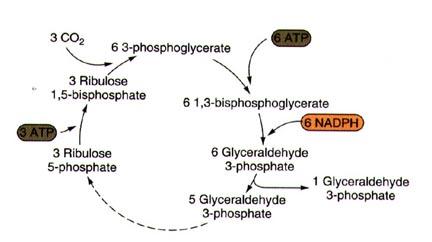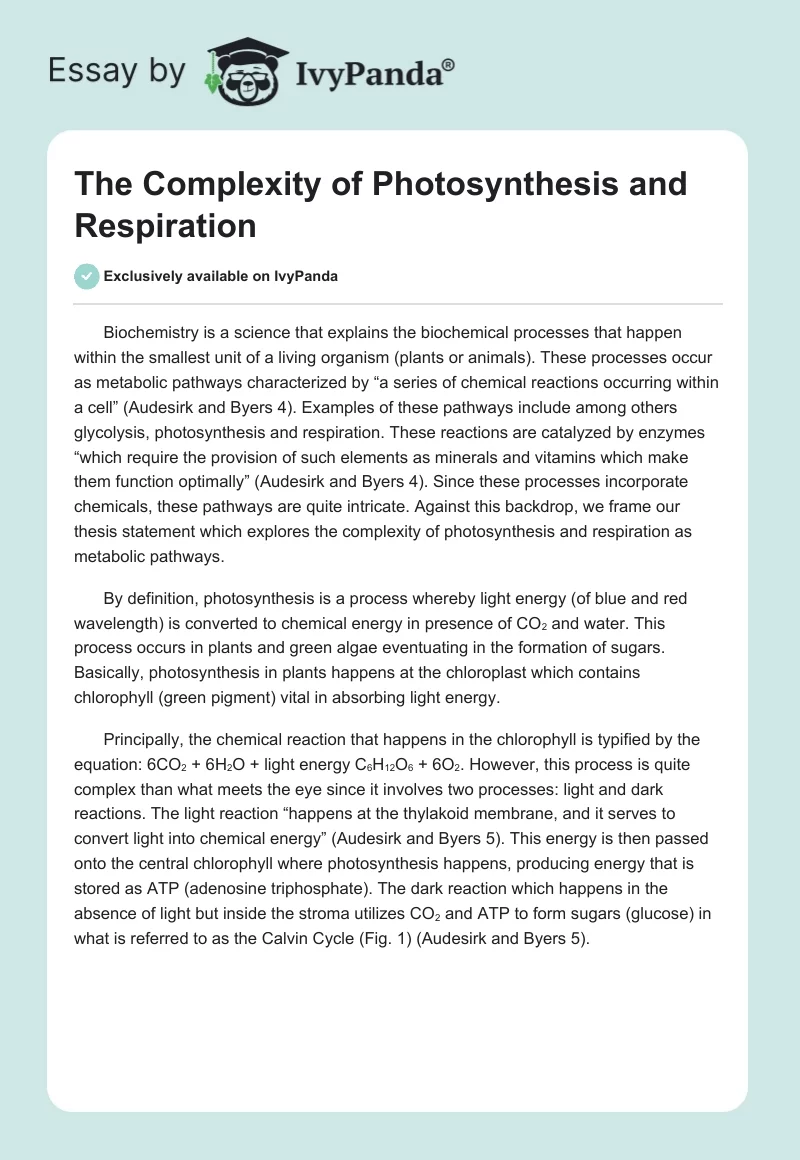Biochemistry is a science that explains the biochemical processes that happen within the smallest unit of a living organism (plants or animals). These processes occur as metabolic pathways characterized by “a series of chemical reactions occurring within a cell” (Audesirk and Byers 4). Examples of these pathways include among others glycolysis, photosynthesis and respiration. These reactions are catalyzed by enzymes “which require the provision of such elements as minerals and vitamins which make them function optimally” (Audesirk and Byers 4). Since these processes incorporate chemicals, these pathways are quite intricate. Against this backdrop, we frame our thesis statement which explores the complexity of photosynthesis and respiration as metabolic pathways.
By definition, photosynthesis is a process whereby light energy (of blue and red wavelength) is converted to chemical energy in presence of CO2 and water. This process occurs in plants and green algae eventuating in the formation of sugars. Basically, photosynthesis in plants happens at the chloroplast which contains chlorophyll (green pigment) vital in absorbing light energy.
Principally, the chemical reaction that happens in the chlorophyll is typified by the equation: 6CO2 + 6H2O + light energy C6H12O6 + 6O2. However, this process is quite complex than what meets the eye since it involves two processes: light and dark reactions. The light reaction “happens at the thylakoid membrane, and it serves to convert light into chemical energy” (Audesirk and Byers 5). This energy is then passed onto the central chlorophyll where photosynthesis happens, producing energy that is stored as ATP (adenosine triphosphate). The dark reaction which happens in the absence of light but inside the stroma utilizes CO2 and ATP to form sugars (glucose) in what is referred to as the Calvin Cycle (Fig. 1) (Audesirk and Byers 5).

The overall reaction that happens in the cycle is shown in the equation below:
“3CO2 + 6NADPH + 5H2O + 9ATP →glyceraldehyde-3-phosphate (G3P) + 2H+ + 6NADP+ + 9ADP + 8Pi” (Audesirk and Byers 5)
To utilize the sugars processed by plants, animals and plants alike initiate respiration processes which can either be aerobic or anaerobic as manifested in most microorganisms. However, the scope of this paper limits itself to aerobic respiration; a process whereby glucose/organic substrate is broken down in the presence of oxygen to release energy, and molecules of water and CO2. The energy is stored chemically as ATP and hence, can be used by other cells within an animal/plant. Basically, in a simplified equation the below reaction occurs:
C6H12O6 + 6O2 → 6CO2 + 6H2O + Energy
Akin to photosynthesis, respiration is a complex phenomenon that involves two processes: glycolysis which eventuates in the formation of pyruvic acid from glucose and a process of oxidizing the product to CO2, NADH, and H2O (Fig. 2). The NADH molecules are utilized in both the electron transport chain and chemiosmosis processes to yield ATP molecules. Of note, this process occurs in the mitochondrion of a cell. This process is summarized as below in a Citric Cycle. The process raw material, pyruvate molecule, is a product of glycolysis. The pyruvate molecule undergoes a decarboxylation reaction courtesy of an enzyme (pyruvate dehydrogenase) to produce acetyl-CoA that is fed in the cycle to finally produce ATP.

In a conclusion, as typified in the cycles above, the metabolic pathways are complex. While the Calvin Cycle is responsible for the manufacture of sugars in plants, the Citric Cycle is a metabolic pathway vital in the utilization of the manufactured sugar to produce energy. Either cycle incorporates several chemical compounds to produce their respective products.
Works Cited
Audesirk, Thomas, and Byers Baldin. Biology – Life on earth with physiology. San Francisco, CA: Benjamin Cummings, 2008. Print.
Doutor, Silva. The major metabolic pathways. Cambridge: Cambridge University Press, 2009. Print.


